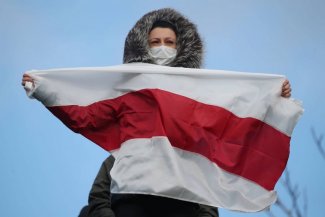Belarus: a demonstration under threat of pacification

On 18 October, another weekly peaceful demonstration by Alyaksandr Lukashenka’s opponents was held in Minsk during which they demanded that the president step down. This time it took place under the slogan of ‘the March of Guerrilla Fighters’, referring to the history of the Belarusian resistance movement during World War II. Around 50,000 people took part in the protest in several separate groups, confirming a downward trend in turnout recorded in recent weeks. Just as with several of the most recent protest actions, in smaller towns the activity of demonstrators was insignificant – the few rallies that were organised in Navahrudak, Zhabinka, Brest, Svietlahorsk and Baranavichy, for example, were attended by only around 100–200 individuals. The protests organised on Saturday by women and students, mainly in Minsk, also proved to be insignificant.
The demonstrations were preceded by numerous threats voiced by representatives of the government, including the deputy minister of internal affairs, Henad Kazakevych. These threats involved the possible use of firearms against the demonstrators, whom the government views as increasingly radical. In addition, the Investigative Committee requested the directors of industrial facilities to provide it with a list containing the names of initiators and attendees of protest actions organised in the first few weeks following the presidential election. These threats were all the more credible because on 12 October in central Minsk the militia used brutal force to disperse a rally attended by more than a thousand pensioners. These actions by militia officers triggered public outrage, which translated into street blockades being organised in various locations in Minsk.
Contrary to what had been announced, on Sunday, 18 October, law enforcement forces refrained from pacifying the demonstrations and limited themselves to blocking the streets and detaining selected protestors, mainly those who gathered in small groups. In several locations, rubber bullets, stun grenades and tear gas were used, albeit on a limited scale. According to preliminary reports, around 240 individuals were detained. Following the demonstration, the head of the interior ministry’s department for fighting organised crime, Mikalay Karpiankou, appeared on state television and once again warned the public that measures will be taken should further protests be organised. He referred to the most radical demonstrators as “street thugs” and said that the militia will soon “crack down on them”. Increasingly radical behaviour on the part of the demonstrators and their intention of provoking law enforcement forces were also mentioned by Dzmitriy Balaba, the head of OMON in Minsk.
On 13 October, Sviatlana Tsikhanouskaya issued an ultimatum for the Belarusian regime. She demanded that Lukashenka step down, all political prisoners be released and that law enforcement forces refrain from using violence. She announced that a nationwide protest action will be organised, if such demands are not met by 25 October. She also said that on 26 October this action may take the form of a general strike covering the entire production sector and service sector, and that road blockades would be organised all over Belarus. Alongside this, on the initiative of the Coordination Council, an online platform was launched for citizens interested in establishing local self-government bodies in individual city districts, as well as in separate housing cooperatives, which is a form of social activity permitted under Belarusian law.
Commentary
- An increasing disenchantment on the part of protest movement participants is resulting from worsening weather conditions and particularly from the government’s refusal to make concessions. Alongside this, citizens are growing weary of their confrontation with the regime, which has now been ongoing for more than two months. This disillusionment was likely aggravated by repeated threats voiced by government representatives last week regarding the possible use of firearms against demonstrators. It should be emphasised that the “March of Guerrilla Fighters” was shorter than previous protests. Combined with lower turnout, this is likely another sign of dwindling potential for protest in Minsk, which in recent weeks has been the last remaining centre of large scale resistance to the regime.
- The attitude of law enforcement forces was more lenient in comparison to last Sunday, when more than 600 individuals were detained. This may have been due to the much tougher intimidation tactics used over the last several days, including the threat that firearms might be used against demonstrators. This has been accompanied by systematic actions by investigative bodies intended to bring criminal charges against the most vocal opponents of the regime, including the leaders of protests organised back in August in large industrial facilities. In addition, demonstrators are frequently referred to as criminals. It seems that this tactic has helped to reduce the number of protest attendees and at the same time has not resulted in an escalation of tensions, unlike on 12 October. Alongside this, the threats announced in the mass media should be viewed as a propaganda message intended to prepare the public for more brutal, targeted actions. It cannot be ruled out that in the coming weeks the government may change its tactics regarding the weekly Sunday demonstrations, particularly if the number of attendees drops below a sufficient level to enable law enforcement agencies to carry out mass detentions in an efficient manner. The government’s failure to make concessions, combined with an aggressive information offensive targeting Lukashenka’s opponents, will result in the present level of social discontent being maintained, which in turn spells a continuation of the political crisis.
- The ultimatum issued by Sviatlana Tsikhanouskaya is an attempt [on the part of the opposition] to boost her significance and present her not only as a symbol of the protest movement but also as its genuine leader. Alongside this, making such radical and unrealistic demands and announcing a general strike, against a backdrop of increasing disenchantment on the part of the public, seems highly risky. If the response of the general public is weak, this would be tantamount to both Tsikhanouskaya herself and the protest movement making a major mistake. This, in turn, will most likely be used by state propaganda as an argument against the opposition. In this context, attempts by the Coordination Council to build an organisational framework, in the form of local self-government structures, to channel Belarusians’ increased civil activity are particularly worthy of note. In the long-term perspective, a grassroots movement of city residents may become a major base for resistance to the regime.





